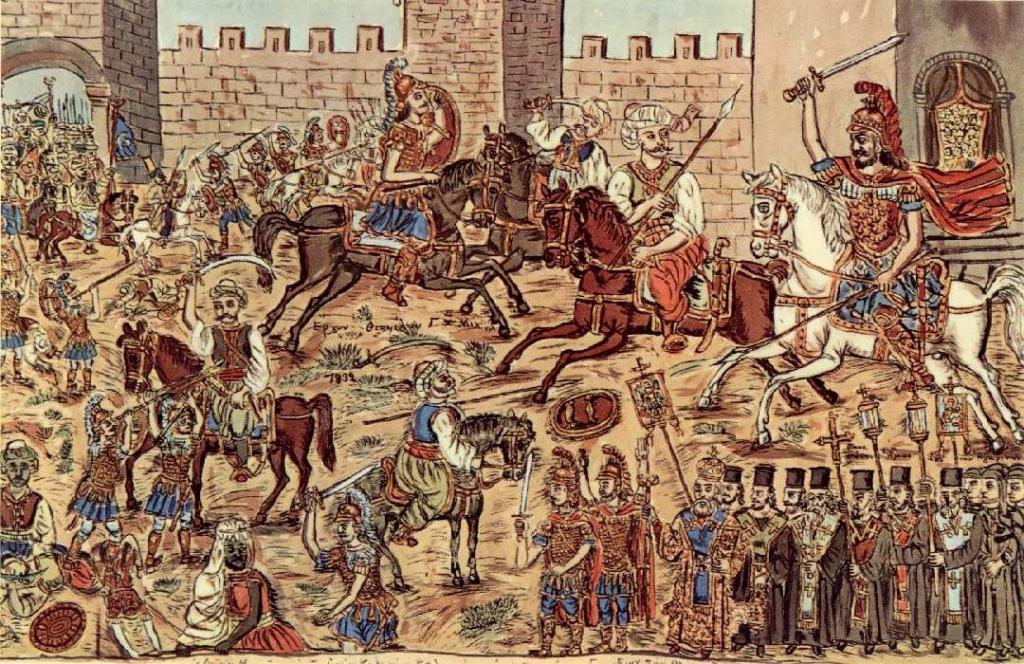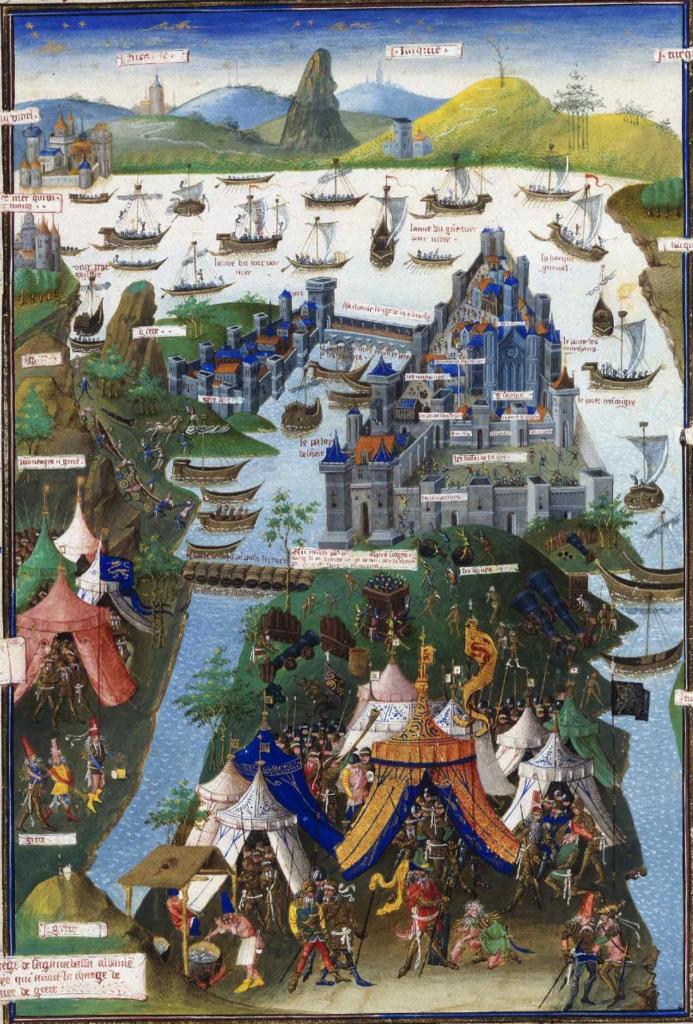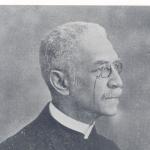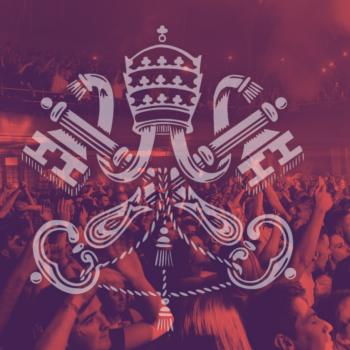This post concerns a year in which not much happened, or at least, far less than we often think. I’ll explain that cryptic remark.
I have published quite a bit on Eastern Christian traditions, most recently in my forthcoming book A Storm of Images: Iconoclasm and Religious Reformation in the Byzantine World (Baylor University Press). That dealt with the eighth and ninth centuries, but more recently I have been working on the Late Byzantine period, and the diverse manifestations of the Byzantine inheritance through subsequent European history and culture: to borrow the title of Nicolae Iorga’s classic work, it concerns “Byzantium After Byzantium.” Mine is an ongoing project, and I am not entirely sure just what the eventual outcome will look like. I know it won’t be a straight history of the era, because we have excellent studies of that kind by Jonathan Harris, Michael Angold, Donald Nicol, and others. Anyway, watch this space.
The year I am discussing is 1453, and more specifically a day in that year, May 29, which is one of the most famous in world history. On that date, the victorious forces of the Ottoman sultan, Mehmet II, captured the city of Constantinople, which had been established some 1,100 years previously as the New Rome, the capital of the Roman Empire. Still in 1453, it remained the capital of an entity that called itself the Roman Empire, and its final Christian ruler bore the distinguished name of Constantine, the eleventh ruler of that name. That Constantine XI, of the Palaiologos dynasty, perished heroically in the final battle. Edward Gibbon, who really admired him, wrote that “The distress and fall of the last Constantine are more glorious than the long prosperity of the Byzantine Cæsars.”
So much is well known and often recounted, and that date of 1453 often appears as a pivotal moment in the titles of textbooks and college history courses. Even so, the actual meaning of that event is subject to many different interpretations: literally a whole book – and a sizable one – could be written on the rhetorical uses of 1453. According to taste, it symbolized the catastrophic fall of a great Christian civilization before the aggression of the faith of Islam; or it was the triumph of the true Islamic faith over Christian error. In modern Turkey, the authoritarian Islamist regime of Recep Tayyip Erdogan has made a point of commemorating this glorious triumph annually, and Erdogan himself has tweeted “May Sultan Mehmed II of the Ottomans and his army rest in peace!” In 2022, he declared that “As our ancestors buried Byzantium, let us hope that today, by building our vision for 2053, we also manage to put in the time warp of history the current Byzantines who are plotting against us.” In contrast, Orthodox Christians recalled the fall of Constantinople as a profound trauma: this was “the day the world ended.”
Older accounts suggested that the Ottoman conquest had directly caused the mass flight of Byzantine scholars to Western Europe, where they sparked the Renaissance in Italy in elsewhere. Coinciding so closely as it does with other key dates, such as the invention of printing and the beginning of European global exploration, the Fall of Constantinople this provides a neatly symbolic marker of the birth of a new world order centered in then-Catholic Western Europe. Different nations have their own particular takes on “the Fall,” their own memories and mythological systems. It has an amazing resonance in Russian history and culture, as well as those of pretty much every Orthodox Christian society.
Another of those mythologies with a strong contemporary relevance involves the supposed clash of civilizations, and specifically the confrontation between a Christian “West” and a demonized Islam. In modern polemics directed against Islam, conservatives often depict 1453 as a historic defeat for Western civilization, and (by implication) a key stage in an Islamic invasion of Europe, a region where, in reality, the Ottomans had already been well established for over a century. This conservative narrative finds a stark visual symbol in the church of Hagia Sophia, once the world’s largest Christian structure, before its conversion to become a mosque. As I’ll suggest in a later posting, you may not realize just how powerful and commonplace those perceptions can be unless you are well versed in the wide world of Far Right conspiracy theory.
Generally, scholars do not write books on years in which nothing particular happened, but an excellent case can be made for a study of this kind focused on 1453. To take a couple of examples, it is certainly true that the Ottoman power grew mightily in Anatolia and south-eastern Europe, replacing what had once been a very powerful Roman/Byzantine realm. But that Byzantine empire had never fully recovered from its conquest and sack by fellow Christians in 1204. If not the Fall of the Roman Empire, this was at least a Fall. Although a Greek empire was restored in 1261, it was very weak and extraordinarily prone to endemic civil wars. It was increasingly hemmed in by fellow-Christians – Serbians and Bulgarians – not to mention the Ottoman Turks. It survived solely and entirely on the strength of the fortifications of Constantinople, which (at least before the coming of gunpowder) could survive almost anything except internal treachery or subversion.
This may be unfair, but I think that when modern writers see 1453 as such a turning point, they are making a fundamental geographical error. They imagine that the Byzantines were the last force protecting some kind of Bosporus bottleneck, and when the city fell, that uncorked the bottle and allowed the Ottoman hordes to pour into Europe. That is nothing like the truth. As early as the 1360s, the Ottomans captured the cities of Adrianople and Philippopolis (Plovdiv) both of which in earlier centuries had been critical bases for Byzantine power in its European territories. In 1369, Adrianople became the new Ottoman capital, significantly located on the European side of the Straits: the Ottomans were already a rising European power. The Bulgarian lands were largely absorbed by 1382, and Serbia never recovered from the hideous slaughter at Kosovo in 1389. The Ottomans took the vital city of Thessaloniki in 1387. In 1394, the Ottoman sultan began a siege of Constantinople. Meanwhile, decades of brutal raiding, massacre, and slave-taking had already destroyed ancient Christian societies across much of Anatolia.
By 1373, the Byzantines became a client state of the Ottomans, subservient vassals, who held very little territory outside Constantinople itself. In 1390, the emperors of the time were forced to join their Ottoman overlords in conquering the city of Philadelphia, the last Christian holdout in the Anatolian peninsula, and a place with Christian origins dating back to the first century.
The Byzantines did stage a minor comeback in the fifteenth century, entirely because the Ottomans suffered a disastrous defeat at the hands of the invading forces of the Central Asian conqueror Timur. But the Ottomans soon regained their power, and (again) besieged Constantinople in 1422. By the 1440s, they had conquered most of south-eastern Europe, establishing Islamic rule over territories where it would remain substantially until the late nineteenth century. As Philip Mansell describes Constantinople in that era,
the city’s population [fell] from a peak of 400,000 inhabitants to about 50,000 Greeks – or `Romans’, as they were still proud to call themselves. By 1400 it had shrunk to a collection of small towns, separated by farms and orchards. In 1453 the last Emperor, Constantine XI, ruled over no more than the city, a few islands and coastal districts and the Peloponnese. Commerce had passed into the hands of Venetians and Genoese. The classical statues had been sold or stolen. The lead on the roof of the imperial palace had been used to mint coins.
When Constantinople actually fell in 1453, there was very little left of the city itself. In its closing days, the empire could muster just seven thousand soldiers, two thousand of whom were Italian mercenaries.
Moreover, even that constrained Byzantine world did not wholly end in 1453: related offshoots and statelets continued in Greece and the Black Sea region until the last was snuffed out in 1475.
From the Ottoman point of view, 1453 was one landmark date of many that occurred in the process of empire building, between (say) 1302 and 1571.
It is reasonable to ask how, if at all, European or world history would have differed if the Ottomans had snuffed out that ghost empire in the 1370s, or 1394, or in 1422. (Actually, that is a real question, to which I will return in a later post). Symbolically, it would be nice to imagine a world in which the Byzantines held out a few decades longer than they did, so that the very last Roman emperor had survived to hear about Columbus’s ventures in the New World. But in practice, 1453 changed very little.
Many things are going on here. There is an obvious ideological component in our focus on 1453, as we so often portray history in terms of a neat clash between religions and civilizations. Moreover, particular states and societies are anxious to stake their claims to historical continuities. More generally, we have a natural tendency to seek convenient dates that we can use as markers, to use in the titles of books and college courses and television documentaries. When we have found those dates, we invest them with far more significance and finality than they actually had at the time. We don’t like to be reminded of the messy realities.
The story warns powerfully against over-stressing watershed dates or moments as “the end of empire,” a process that is usually far more prolonged and multi-faceted than such an approach would suggest.
The books referred to above are:
Michael Angold, The Fall Of Constantinople To The Ottomans: Context And Consequences (New York: Pearson, 2012)
Jonathan Harris, The End of Byzantium (Yale University Press, 2010)
Nicolae Iorga, Byzantium after Byzantium (originally published 1935: Portland: Center for Romanian Studies, 2000)
Philip Mansell, Constantinople: City of the World’s Desire, 1453-1924 (St. Martin’s, 1995)
Donald M. Nicol, The Last Centuries Of Byzantium, 1261-1453 2nd ed. (originally published 1972. Cambridge University Press, 1993)
You can also find my working bibliography on this topic here.


















